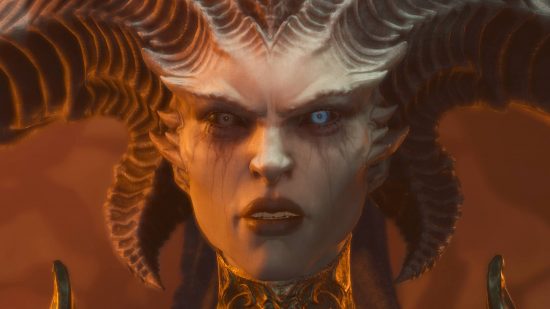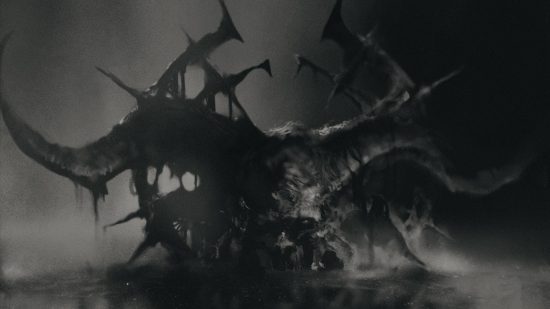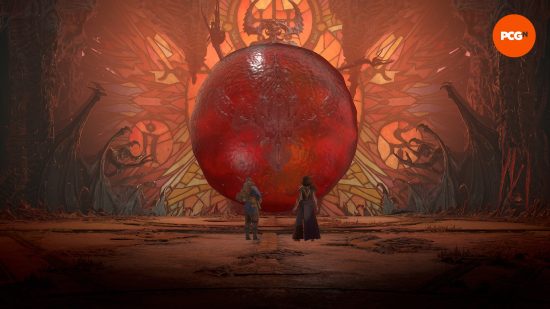From the moment her veiny, translucent red foot stepped into Sanctuary, I have been obsessed with Diablo 4’s prime antagonist, Lilith. Her soothing voice, her twisted quest for justice – Lilith ensnared me from the get-go, no eerie Blood Petals required. But, having played through the entire campaign in a post-BlizzCon, gore-fuelled spree, I’ve realized that, despite the fact her horned visage was the face of Blizzard’s Diablo 4 marketing, the fourth chapter of Sanctuary’s seemingly never-ending saga of strife isn’t about Lilith – and I’m okay with it. Blessed Mother, forgive me.
While Lilith and Inarius perfectly embody Diablo 4’s iteration of Sanctuary’s Eternal Conflict, when you actually check out how much screen time they both get in the RPG, it’s relatively little – about 30 and 15 minutes respectively in a 35-hour campaign. While I’ll never forget my first meeting with Inarius, Gabe Kunda’s booming voice reverberating off the calcium-white walls of the Alabaster Monastery, or my first glimpse of Lilith, haunting Nevesk with her promises of freedom, we just don’t see that much of them.
Be aware that’s where the spoiler-free section ends: there are several up ahead.

The game’s penultimate moments comprise both Lilith and Inarius’ rather brutal deaths – something that, while I think their respective endings were poetic and beautifully done, left me feeling slightly deflated. It was a sense of ‘oh, Lilith and Inarius are dead now, what’s next?’
In some ways, it felt anticlimactic – the romantic duo were, from the outside, at the heart of Diablo 4. Their faces were the marketing campaign, their lover’s strife the core of the base game’s campaign. It felt like that moment where you realized that Lady Dimitrescu is only in Resident Evil: Village for the first quarter of the game, despite the entire ‘tall vampire lady’ campaign Capcom had surrounding it.
Yet, while Lady D’s quick demise in Village was, quite honestly, just a bit disappointing, I’m not that upset with the fact that Lilith looks like she’s gone for good – although, in the world of Sanctuary, is evil ever truly bested? Instead, I’m pretty excited for Vessel of Hatred. Why? Because Mephisto, the most underrated Diablo Prime Evil, is finally getting the stage he deserves.
I remember (rather smugly) announcing to my partner that the black, bloodied wolf we saw in the opening scenes of Diablo 4 was, indeed, Diablo, and being rather proud of myself for my seemingly impressive deduction. However, while I was eventually proven wrong (just this once), the fact that our canine companion is Mephisto was music to my ears.
First appearing in Diablo 2 alongside his brothers, Baal and Diablo, we haven’t seen much of him since then (unless you have the adorable Mephisto pet in Diablo 3, then you’ll see him all the time). Easily the most cunning and complex of the three Prime Evils, his machinations drive every single bit of Diablo 4’s campaign, meaning he feels very much like ‘the big bad’ versus his rebellious daughter. Every step of the way, Mephisto is pulling the strings – even up until the end, where he knows that Neyrelle will imprison him in the Soulstone instead of Lilith – in fact, he’s counting on it.
He’s also a constant earworm for the player, first appearing in the snowstorms of the Mistral Woods to lead you to the Horadric Vault – a scene that, thanks to the Tristram throwback, is one of my favorites in the entire game. Each time you meet, he feels more confident, more in control, more dangerous. Couple that with Steve Blum’s gravelly, almost canine voice, and you’re set up with a character that you know is going to become a real problem.
And his return to the stage makes perfect sense given Diablo 2’s focus on Diablo, then Baal, then the return of Diablo, and the addition of Malthael in Diablo 3. He’s the villain I’ve been waiting for for so long – even before Lilith – and that’s why I’m okay with the Daughter of Hatred’s untimely demise. Blizzard has set Mephisto up so beautifully, and his taunting “there will be no salvation in the light” has me desperate to re-explore the corrupted heart of Kurast.
While evils come and go, then come and go again, right now Mephisto reigns supreme, and it’s glorious. With the Vessel of Hatred release date set for next year, and no doubt a couple of seasons to keep us going in the meantime, I’m infected by Mephisto’s hatred. Diablo 4 has set him up as the perfect villain: now he just has to prove his worth. After all, Diablo 4 isn’t Lilith’s story; it’s Mephisto’s.


